Observation of Fine Time Structures in the Cosmic Proton and Helium Fluxes with the Alpha Magnetic Spectrometer on the International Space Station
We present the precision measurement from May 2011 to May 2017 (79 Bartels rotations) of the proton fluxes at rigidities from 1 to 60 GV and the helium fluxes from 1.9 to 60 GV based on a total of $1 \times 10^9$ events collected with the Alpha Magnetic Spectrometer aboard the International Space Station. This measurement is in solar cycle 24, which has the solar maximum in April 2014. We observed that, below 40 GV, the proton flux and the helium flux show nearly identical fine structures in both time and relative amplitude. The amplitudes of the flux structures decrease with increasing rigidity and vanish above 40 GV. The amplitudes of the structures are reduced during the time period, which started one year after solar maximum, when the proton and helium fluxes steadily increase. Above $\sim 3$ GV the p/He flux ratio is time independent. We observed that below $\sim 3$ GV the ratio has a long-term decrease coinciding with the period during which the fluxes start to rise.
The proton flux $\Phi_p$, helium flux $\Phi_{He}$, and p/He flux ratio as a function of rigidity (in units of GV) at the top of AMS including errors due to statistics, time dependent systematic errors and the total systematic error. Contributions to the time dependent systematic errors are from: the trigger and the reconstruction efficiency. Contributions to the total systematic error are from: the acceptance, the background contamination, the geomagnetic cutoff factor, the event selection, the unfolding, the rigidity resolution function, the absolute rigidity scale, and the time dependent systematic errors. The statistical errors for the ratio are the sum in quadrature of the relative statistical errors of the fluxes multiplied by the ratio. The time dependent systematic errors for the ratio are the sum in quadrature of the relative time dependent systematic errors of the fluxes multiplied by the ratio. The systematic errors from the acceptance for the ratio are added in quadrature. The correlations in the systematic errors from the unfolding and the absolute rigidity scale between the fluxes have been accounted for in calculating the corresponding systematic errors of the ratio. The contributions of the individual sources to the systematic error are added in quadrature to arrive at the total systematic uncertainty on the ratio.
The CRDB at LPSC/IN2P3/CNRS, online since 2013, is fully described in Maurin et al. (2014, 2020)
The CRDB © SSDC is developed at the Space Science Data Center, a facility of the Italian Space Agency (ASI).
